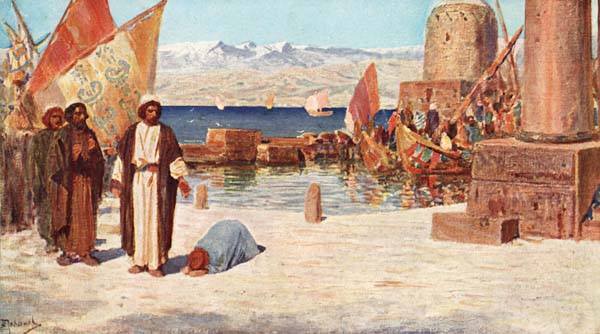Pentecost 15, September 6,
2015
Mark 7:24-3724From there he set out and went away to the
region of Tyre. He entered a house and did not want anyone to know he was
there. Yet he could not escape notice, 25but
a woman whose little daughter had an unclean spirit immediately heard about
him, and she came and bowed down at his feet.26Now
the woman was a Gentile, of Syrophoenician origin. She begged him to cast the
demon out of her daughter. 27He said to her, “Let the children be fed
first, for it is not fair to take the children’s food and throw it to the
dogs.” 28But she answered him, “Sir, even the dogs
under the table eat the children’s crumbs.” 29Then he said to her, “For saying that, you may
go—the demon has left your daughter.” 30So
she went home, found the child lying on the bed, and the demon gone.
31Then he returned from the region of Tyre, and
went by way of Sidon towards the Sea of Galilee, in the region of the
Decapolis. 32They brought to him a deaf man who had an
impediment in his speech; and they begged him to lay his hand on him. 33He took him aside in private, away from the
crowd, and put his fingers into his ears, and he spat and touched his
tongue. 34Then looking up to heaven, he sighed and said
to him, “Ephphatha,” that is, “Be opened.” 35And
immediately his ears were opened, his tongue was released, and he spoke
plainly. 36Then Jesus ordered them to tell no one; but
the more he ordered them, the more zealously they proclaimed it. 37They were astounded beyond measure, saying,
“He has done everything well; he even makes the deaf to hear and the mute to
speak.”
Have you ever sat in the emergency room for hours? It’s an
interesting experience. You see people on their worst days- they’re in pain,
they’re sick, they’re there because they need help. If you’re there, observing,
you’re usually there because you’re in need, too, or someone you care about is
in pain or ill. It’s not easy to sit there, waiting for your name to be called,
watching as the nurse calls in people who are in worse shape, because obviously,
from your perspective, the thing you are suffering from is bad. But we usually
understand on an intellectual level, even if we’re in great pain, is that the
hospital will see the people who are sickest first. But imagine- what if you went to the hospital,
and instead of taking patients by the seriousness of their affliction, they
took people according to their race or cultural heritage. I like to think that
in this day and age, we’d all insist that the woman with the heart attack, the
kid with the gunshot wound, that they would be seen first, regardless of skin
color.
But that scenario is kind of what Jesus says to this Syrophoenician woman. She comes to Jesus, begging for help. She’s desperate. And Jesus tells her that she’s going to have to get in line- behind the Jewish people.
What’s going on? Why does Jesus treat her this way? And why, out
of all the stories that Mark could tell, why does Mark include this less than
flattering story about Jesus?
Well, first, there’s a big clue about the situation in the first
sentence of this story. It’s in the geography. “From there, he set out and went
to the region of Tyre.” The region of Tyre, which included Sidon in the north, was
the northern-most territory included in the Promised Land, back when Joshua led
the people into the land of Canaan. It was a place of promise, of rest after
long journeys, of new life. But Tyre and Sidon weren’t small, dusty backwaters.
They were ancient and well-known cities. Not only had they been around and
well-populated for over 1,000 years, they were beach towns, resort towns. So
when Mark tells us, “he set out and went to the region of Tyre,” and that he
entered a house and didn’t want anyone to know that he was there, we could
translate: Jesus headed to the beach, and he wanted to be anonymous. In short, he was exhausted and needed a
vacation.
 Of course, he had barely
sat down since he started his public ministry at the synagogue back home in Nazareth
and then healed Peter’s mother-in-law. From that time onward, people started
mobbing Jesus, seeking healing. And everywhere he went, it was like Friday
night in the ER waiting room.
Of course, he had barely
sat down since he started his public ministry at the synagogue back home in Nazareth
and then healed Peter’s mother-in-law. From that time onward, people started
mobbing Jesus, seeking healing. And everywhere he went, it was like Friday
night in the ER waiting room.
So Jesus has just tried to get a few days off, and instead, like
all the preceeding healing stories, word has gotten out, and a woman Jesus
doesn’t even know comes looking for him. So here she comes, desperate, and
here’s Jesus, desperately tired. They are two people at their worst.
It’s at that point that Jesus and the Syrophoenician woman have
a conversation that changes everything. She begs him to heal his daughter, and
he refuses, telling her to get in line, and basically calling her a dog. It’s
not Jesus’ finest moment. Where is the Jesus who says things like, “Let the children come to me” and “Ask and you shall receive” and “your faith has made you well.”
Instead, he tells her that the children come before the dogs.
Perhaps her courage was born
of desperation, but God uses her and her faith to heal and restore both of
them. She expands Jesus’ vision to include the Gentiles, the outsiders, those
that others consider beneath their notice. Then Jesus sees her, truly sees her,
and finds the energy to heal her daughter.
But she is not the only one
changed by their encounter, and we know this, too, because of geography. In the
very next story, which we heard read in our gospel today, Jesus returned from
Tyre to the region of the Decapolis near the Sea of Galilee by way of Sidon. To
give you a little context, it would be like saying, Jesus returned from Cannon
Beach to Bend by way of the Olympic Peninsula.
It was not exactly on the way. He heads east by going north. It makes no sense.
But when they bring to him a
deaf man in Sidon, who is almost certainly a Gentile, Jesus does not hesitate
but heals him. And it is as if every scripture of the Old Testament has been
fulfilled.
 Mark may have included the
story because it was part of his telling of what Jesus did, but this story
would have become significant for Gentiles entering the church and even more
important for Jewish people who followed Jesus first but thought of gentiles as
dogs. This story remains a powerful story for us, the followers of Jesus.
It is a powerful story for those of us who might feel like the children of God, but on our worst days we may
feel unworthy of sitting at the table. It is especially powerful today as we hear stories of the descendants of the Syrophoenician people who are even now seeking a place for new life. This story reminds us that there is no
hierarchy in Jesus’ waiting room, that Jesus the Doctor will see us all. Jesus
heals us all, feeding us with abundant life and welcoming us all to the table
of life.
Mark may have included the
story because it was part of his telling of what Jesus did, but this story
would have become significant for Gentiles entering the church and even more
important for Jewish people who followed Jesus first but thought of gentiles as
dogs. This story remains a powerful story for us, the followers of Jesus.
It is a powerful story for those of us who might feel like the children of God, but on our worst days we may
feel unworthy of sitting at the table. It is especially powerful today as we hear stories of the descendants of the Syrophoenician people who are even now seeking a place for new life. This story reminds us that there is no
hierarchy in Jesus’ waiting room, that Jesus the Doctor will see us all. Jesus
heals us all, feeding us with abundant life and welcoming us all to the table
of life.




No comments:
Post a Comment